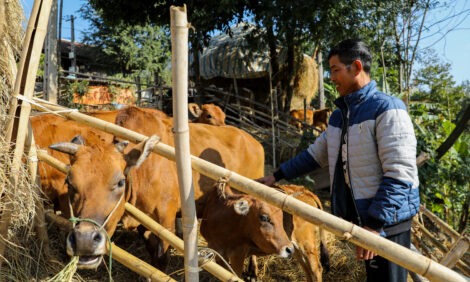



Salmonella In Cattle In GB - 2009
Overall, the number of cases of salmonella has increased in cattle in the UK, according to the Veterinary Laboratory Agency.
There is no routine Salmonella monitoring of cattle in Great Britain, therefore the majority of isolates come from cattle with clinical disease.
The number of reports is dependent on the total cattle population and the number of diagnostic submissions to Government veterinary laboratories. As in previous years, the majority (97.0 per cent) of Salmonella incidents (n = 764) in cattle were from samples taken for clinical diagnostic purposes and originated from cattle on farms.
There were 25.5 per cent more Salmonella incidents in cattle reported in 2009 (764) than in 2008 (609). Incidents of Salmonella Typhimurium decreased by 13.5 per cent compared with 2008 (from 74 to 64).
Of the 764 incidents in cattle, 53.1 per cent were in adult cattle, 30.5 per cent in calves and 16.4 per cent in cattle of unknown age. Salmonella Dublin remained the most common serovar isolated from cattle (68.6 per cent of incidents) (Fig 2.1), followed by Salmonella Typhimurium (8.4 per cent of incidents), S. Mbandaka (8.1 per cent of incidents), Salmonella Montevideo (3.7 per cent of incidents) and S. Anatum (2.7 per cent of incidents). There were three reported incidents involving S. Enteritidis in 2009 (an increase of two compared to 2008).
Salmonella Dublin
For the 11th consecutive year, S. Dublin was the most common serovar in adult cattle (63.8 per cent of incidents) and in calves (74.8 per cent of incidents).
As in previous years there was a seasonal association of incidents due to S. Dublin, although the peak was observed in October (rather than at the end of the previous year) and more in accord with what had been seen in the late autumn months of 2005-2007 (see Fig 2.2). Salmonella Dublin is the most common serovar associated with abortion in cattle. During 2009 the number of incidents of S. Dublin abortion in cattle was much higher than in 2008 (75 incidents, 9.1 per cent of abortions where a diagnosis was reached in 2009 compared with 40 incidents, 3.3 per cent of abortions, where a diagnosis was reached in 2008).
Salmonella Typhimurium
Salmonella Typhimurium was still the second most common serovar in cattle in 2009, being just ahead of Salmonella Mbandaka. It was responsible for 8.6 per cent of incidents in adult cattle and 7.3 per cent of incidents in calves. During 2008 S. Typhimurium had been responsible for 15.9 per cent and 8.6 per cent of incidents in adult cattle and calves respectively. Of all the Salmonella Typhimurium incidents in 2009, 54.7 per cent (35) were recorded in adult cattle, 26.6 per cent (17) in calves, and 18.8 per cent (12) in cattle of unknown age. As in previous years DT104 was the most frequently recorded phage type, representing 34.3 per cent of Salmonella Typhimurium incidents in adult cattle and 41.1 per cent of Salmonella Typhimurium incidents in calves. However, the number of incidents due to Salmonella Typhimurium DT104 was slightly lower (n = 23) than in 2008 (n = 27) (Table 2.3). This confirmed a decreasing trend since 2005 - 2006, when there were over 100 incidents per year.
In common with 2008, when two peaks in incidents were seen in January and June (see Fig 2.4), two peaks were also seen in 2009 but in July and October (but total numbers were low at six and eight incidents in each peak).
The number of incidents due to a phage type of the DT104 lineage (which comprises DT12, DT104b, DT120 and U302) was 32, compared with 49 in 2008 (Table 2.3). Salmonella Typhimurium DT193 was responsible for seven incidents during 2009 (nine in 2008) being the third most common phage type, behind DT104 and DT104b. Two incidents due to Salmonella Typhimurium DT1 were also reported in 2009 (one each in 2008 and 2007) and no incidents due to Salmonella Typhimurium DT191a were reported in 2009, with only two incidents ever reported (2008), since reporting began in 1985.
A monophasic variant of Salmonella Typhimurium DT193 and DT120, identified as S. 4,5,12:i:- (because it cannot be fully serotyped) has been identified as a new epidemic strain that has recently emerged in Europe. Similar strains of different phage types including U302 and DT191a also exist in Europe and elsewhere. The most recent pandemic strain is usually resistant to: ampicillin, tetracycline, streptomycin and sulphonamide. VLA undertakes phage typing of this strain as it is derived from S. Typhimurium.
There was one incident of S. 4,5,12:i:- DT41 from adult cattle in 2009, this phage type is normally associated with wild birds. Incidents involving S. 4,5,12:i:- DT193 have trebled from four in 2008 to 13 in 2009 involving almost equally calves (six incidents) and adults (seven incidents); incidents were reported only in the six months between June and December. Apart from one in Wales and two in the Midlands, the remaining incidents were in the south and south-west of the country, and were associated with diarrhoea.
Other serovars
During 2009, three incidents of S. Enteritidis were reported and investigated. Salmonella Enteritidis PT11 (normally associated with hedgehogs) was isolated from a thin three-year-old cow that died at pasture and was examined post mortem at the local Regional Laboratory. It had been affected by chronic diarrhoea for some time and the cause of death was a typhlo-colitis. The herd was undergoing organic conversion. There were a number of other cows and calves on the holding but no further illness was reported. On another premises Salmonella Enteritidis PT8 (normally associated with poultry) was isolated from an adult milking cow affected by diarrhoea which improved and eventually recovered. The final incident also involved Salmonella Enteritidis PT8 which was isolated from a diarrhoeic calf on a mixed farm/retailer premises.
S. Mbandaka continued to increase in 2009 (62 incidents compared with 29 in 2008) (Table 2.1) and was responsible for 8.1% of all Salmonella incidents (9.1 per cent in adults and 7.7 per cent in calves). Forty-three of the incidents were in the South West (Cornwall, Devon, Dorset and Somerset) with the remainder in the Midlands and two in Hampshire. There was no clear seasonal pattern although the largest number of incidents, 12, was seen in December, when most cattle would be housed. Two incidents were associated with abortion, the remainder being recorded as ‘diarrhoea or malaise’. In 2009 S. Mbandaka was the third most common isolate from feed ingredients, mostly from soya bean residue meal. Contamination of this common feed ingredient often occurs during the cooling process after oil extraction. During 2009 Salmonella Montevideo, another soya-related serovar, has continued to increase in cattle (28 incidents in 2009 and 19 in 2008) representing 3.7 per cent of all incidents. This year most incidents were in adults, with only three affecting calves and the longer term trend in increased incidence appears to be driven by adult cattle infections. Incidents occurred in ten months of the year with a peak in June. In 25% of the 28 incidents abortion was the main clinical sign recorded, a reduction from approximately 35% of the 19 incidents reported last year.
With the reduction in summer grazing of dairy cattle many of these normally transient Salmonella serovars may become endemic in herds. During 2009 the number of incidents due to S. Anatum, 21, was similar to the 19 recorded in 2008 and represented 2.7 per cent of all incidents. Fifteen of these incidents were recorded in adult cows. The number of incidents in calves in 2009 doubled since 2008 to four, whilst the incidents in adults decreased by one to 15. S. Anatum is often associated with wildlife found on cattle farms.
The number of incidents of Salmonella Newport decreased in 2009, eight incidents reported compared with 17 in 2008, representing one per cent of all incidents. Isolates of S. Newport from Great Britain continued to be monitored for multiple drug resistance following the emergence of MDR S. Newport in the USA where some strains have shown resistance to at least nine antimicrobials, particularly cephalosporins. All eight isolates were fully sensitive to the panel of 16 antimicrobials and are likely to be strains originating from badgers.
In 2009 there were a number of ‘firsts’ for isolations of phage types of Salmonella Typhimurium:- Salmonella Typhimurium DT66A – never before reported in any UK species; Salmonella Typhimurium DT80 – never reported in cattle or livestock before 2009 (occasional reports in zoo species (mainly birds); Salmonella Typhimurium DT101 – never reported before 2009 in any species and also reported in horses for the first time in 2009; Salmonella Typhimurium U320 – never reported before 2009 in any species. Many of these apparently ‘new strains’ may result from extension of phage typing schemes rather than emergence of new clonal groups of Salmonella.
Also S. Rissen was recorded in 2009 and before that in 1996, whilst S. Heidelberg was last recorded in cattle in 2002. Salmonella 5:58:1z13z28:26 has never been reported in GB before in any species. The ‘firsts’ from last year, S. Cerro, S. Alachua and S. Dusseldorf were not seen this year whilst there were two incidents of S. Oslo (one from an adult cow and one from an animal of unreported age). Most of these irregularly occurring serovars are associated with contaminated feed ingredients.
In 2009 there were ten Salmonella reports of non-GB origin reported from cattle, these were; six reports of S. Typhimurium DT104, two reports of S. Mbandaka and single reports of S. Anatum and S. Dublin. These reports have been excluded from the tables and figures of this publication. Importation of new strains remains a constant risk. The Salmonella incident map covering cattle shows, by county, the density of holdings and Salmonella incidents.
Note that the Salmonella incidents are randomly located within counties and do not indicate the actual locations of incidents. The majority of Salmonella incidents are located in cattle dense regions of GB; South West and North West England, Wales and South West Scotland. Salmonella Dublin incidents appear to be predominantly distributed amongst western cattle dense areas where rainfall and liver fluke populations are likely to be higher, whereas other Salmonella serovars including Salmonella Typhimurium appear to aggregate around the Welsh borders and South West England. In South East England there was also a notable distribution of Salmonella Typhimurium incidents, largely in the absence of Salmonella Dublin.


